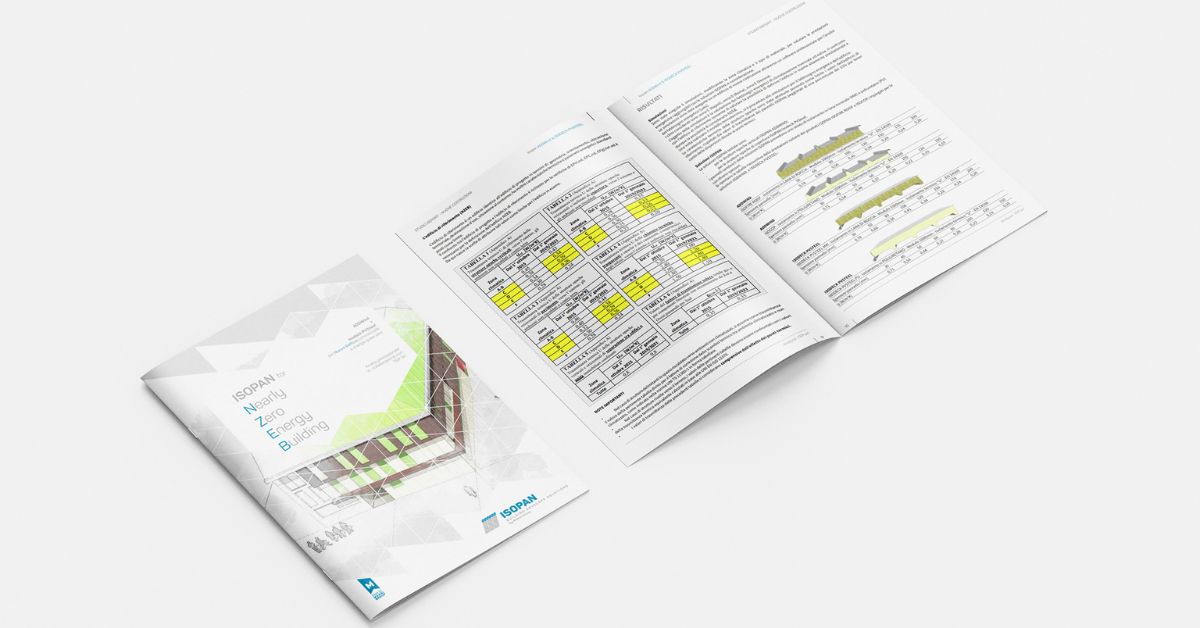For many years now, the word sustainability has become part of the vocabulary of the building world, with a view to building in a way that respects the planet and future generations.
Technological innovations, new ways of building and experimental materials include NZEB buildings, buildings with very low energy consumption, an ideal field of experimentation where projects and products can be designed and tested.
And it was with this in mind that ISOPAN, together with the consulting company TEP s.r.l., wanted to put two of its main products to the test:
- ADDWind, a system for ventilated facades;
- Isodeck PVSteel, insulating sandwich panels for roofs;
evaluating its energy performance through a design case study and finally analysing the results in relation to the parameters imposed by the regulations.
What is a “Nearly Zero Energy Building”
It is now more than 10 years ago that the European Directive 2010/31/EU, known as EPBD, was drafted. It stipulated the obligation for member states to achieve high energy standards for new public authority buildings from 31 December 2018 and for all new buildings from 31 December 2020.
This introduced the concept of NZEB, or 'Nearly Zero Energy Building', to define a building with such a high energy performance that it requires 'almost zero energy', one step away from self-sufficiency.
As buildings are one of the world's main sources of emissions (just think of the impact of boilers in winter and air conditioners in summer), it is clear that the issue is of crucial importance in the journey towards the new sustainable world of which so much is spoken.
In Italy, the process that introduced the topic of energy saving and efficiency already started with Legislative Decree 192/2005, which was later amended to integrate what was required at European level.
The Ministerial Decree of 26/06/2015 defines the parameters and benchmarks for assessing the performance of an NZEB:
- H'T, global average heat transfer coefficient;
- Asol,est/Asup useful, summer equivalent solar area per unit of useful area;
- EPH,nd, thermal performance index for heating;
- EPC,nd, thermal performance index for cooling;
- EPgl,tot, overall energy performance index;
while Legislative Decree 28/11 stipulates the mandatory integration of renewable energy sources in new buildings and existing buildings undergoing major renovation.
ISOPAN products for NZEB
The case study, conducted by carrying out simulations on an existing building in different climatic zones, thus allowed a detailed evaluation of the performance offered by ISOPAN products in the context of an architectural project that, in the face of legislative impositions, imposes a very high standard of quality and performance of building components. The ultimate goal is to assess the thermal performance of the building enclosure, thus excluding plant engineering simulation.
ISOPAN products analysed are:
- ADDWind, a system for ventilated facades;
- Isodeck PVSteel, a system for ventilated facades;
Specifically, the ADDWind system is ISOPAN's new family of solutions for the world of ventilated façades.
The thermal insulation function is performed by the polyurethane or mineral wool panels, while aesthetic flexibility is guaranteed by the external cladding: the wide variety of sizes, colours and types of finishing elements allows each project to be customised according to needs and preferences, while ensuring the high durability and mechanical resistance of the system itself.
The dry fastening system ensures fast and easy installation.
Isodeck PVSteel, Isopan's patented product, is dedicated to the construction of flat roofs. The panels consist of a core made of polyurethane foam or mineral wool and a double metal cladding that protects the insulation material. The outer cladding, pre-coupled with thin synthetic film (PVC or Polyolefin TPO), guarantees UV and water resistance.
The synthetic membranes used, by means of specific formulations that can be engineered to achieve higher SRI values, make it possible to significantly reduce overheating of the roof covering and the resulting heat island phenomenon.
Simulation methodology
The simulation of the project building was approached from certain premises:
- transmittance limit values for opaque vertical closures, roofing, floors and glazed enclosures were taken as those of the reference building;
- Against the 6 climate zones into which Italy is divided, zones C (Naples), D (Rome) and E (Verona) were examined;
- the parameter Asol,est/Asup useful was not taken into account as it relates to the transparent enclosure, while the enclosure parameters EPH,nd and EPC,nd were evaluated;
- a worsening percentage was applied to the H’T parameter and the transmittance values of the ISOPAN panels to take into account the effect of thermal bridges;
in the case of structures delimiting the heated space towards non-air-conditioned rooms, the transmittance is assumed to be the value of the relevant table divided by the correction factor of the heat exchange between the air-conditioned and non-air-conditioned environment, as indicated in the UNI TS 11300-1 standard in tabular form;
- In the case of structures facing the ground, the values in the relevant tables must be compared with the equivalent thermal transmittance values calculated according to EN ISO 13370.
Using the professional software for analysing energy requirements LETO, 6 different simulations were then carried out, combining the three different climate zones with panels characterised by different thicknesses and materials, and assessing the energy requirements for winter and summer air conditioning.
Analysis of results
At the end of the simulation, data were collected from the software concerning:
- EPH,nd, energy performance index for heating requirements;
EPC,nd, energy performance index for cooling requirements;
by climate zone and material and compare them with the values of the reference building.
In all six simulations, for both heating and cooling requirements, the values produced by the software are lower than those of the reference building.
It is therefore possible to define the building, realised with the proposed Isopan solutions, as high performance and classify it as NZEB as it requires less energy than the ideal building imposed by the standards as a benchmark.


